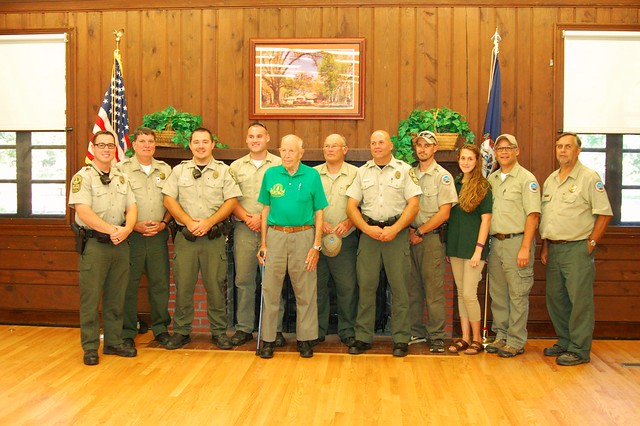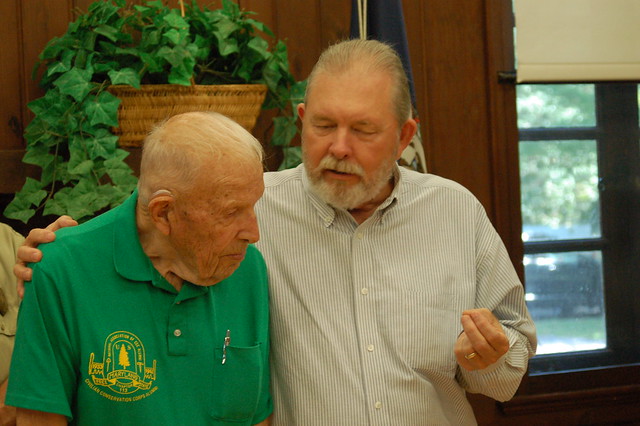Read Our Blogs
Past Meets Present at Westmoreland State Park
A unique legacy that is not soon forgotten and is evident all around the Commonwealth of Virginia, and is also found at Westmoreland State Park.
Original log cabin built by the Civilian Conservation Corps (CCC)
These days when I say CCC some people might think I am talking about something to do with communication, a rock 'n' roll band, a college or a myriad of other possibilities. But say CCC to those of us involved with Virginia State Parks or a history buff and there is an entirely different response.
We know that the CCC is an acronym for the Civilian Conservation Corps (CCC) that built the first six Virginia State Parks in the 1930’s, and we get all excited! We especially get excited when we get to meet one of those Corps members from the CCC.
A special visit
So on a sunny Friday afternoon at historic Murphy Hall, yes an original CCC building traditionally called The Tavern, where The “Boys" gathered for a little bit of fun in those days, Westmoreland State Park staff, retired DCR Deputy Director/VA State Parks Director, Joe Elton and his wife, Patty and I got to meet 94 year old Walter (Walt) Atwood (photo right).
He and his friend and author Edward Slagle, are traveling about Virginia and Maryland visiting as many CCC sites as possible. Mr. Slagle has written a book Civilian Conservation Corps Legacy and is about "Passing the Legacy to Future Generations" and is working on a second edition that should be out soon.
Mr. Atwood served in the CCC in Wyoming and Idaho in 1940’s where he was a clerk and on occasion, called to fight fires. He earned $30 a month, $5 of which he got to keep and $25 of that went home to support his family, thus supporting the community. He laughs when he said he got a raise and was able to keep $8 a month, “That was really something!”
When asked how he felt about the CCC, he proudly said ”It provided a frame work that kept this country going.”
Westmoreland State Park staff stand tall with Mr. Atwood
With retired DCR Deputy Director and former State Parks Director sharing stories
What came next
After his time in the Corps, he lived an exciting life serving in the US Air Force just in time for WWII. He was also a polygraph expert working for the government after World War II.
Walter Atwood has been president of the National Association of Civilian Conservation Corps Alumni and chairman of the board of the Civilian Conservation Corps Legacy. He has been involved with its members for a long time and still very active with the Alumni and Legacy Associations.
 CCC fountain restored by staff, a local stone mason
CCC fountain restored by staff, a local stone mason
and Friends of Westmoreland State Park
History
If you are not familiar with the history of the Civilian Conservation Corps, it was formed in 1933, the CCC, was one of the first New Deal programs. It was a public works project intended to promote environmental conservation and to build good citizens through vigorous, disciplined outdoor labor. Close to the heart of President Franklin D. Roosevelt, the CCC combined his interests in conservation and universal service for youth.
The CCC operated under the Us Army’s control using regular and reserve officers, together with regulars of the Coast Guard, Marine Corps and Navy to temporarily command companies. By September 1935 over 500,000 young men had lived in CCC camps, most staying from six months to a year. The work focused on soil conservation and reforestation. Most importantly, the men planted millions of trees on land made barren from fires, natural erosion, or lumbering. In fact, the CCC was responsible for over half the reforestation, public and private, done in the nation’s history. Corps members also dug canals and ditches, built over thirty thousand wildlife shelters, stocked rivers and lakes with nearly a billion fish, restored historic battlefields, and cleared beaches and campgrounds.
According to the CCC Legacy, “In less than 10 years, the Civilian Conservation Corps built more than 800 parks and planted nearly 3 billion trees nationwide.” And of course, when I went on the Legacy website to get that quote, there was Mr. Atwood’s picture front and center!
Energetic at nearly 95
It’s difficult to believe that Mr. Atwood is 94 soon to be 95 in another six months. He moves better than some people half his age. His energy and spirit is amazing. I truly enjoyed getting a chance to talk with him and Mr. Slagle too.
While they were in Westmoreland County, they made a visit to George Washington’s Birthplace National Monument where the CCC had also done some work. For fun they ate Frog (fig, raspberry, orange & ginger) jam at Westmoreland Berry Farm and made a stop at the Westmoreland County Museum and James Monroe’s Birthplace.
Mr. Atwood with the Westmoreland State Park sign and CCC emblem
Come out for a visit
If you would like to see some of the structures and parks built by the CCC, make a visit to Westmoreland State Park or one of the other 6 original state parks built in Virginia:
Hungry Mother State Park, Douthat State Park, Staunton River State Park, Fairy Stone State Park, Seashore (later changed to First Landing State Park). This year marks the 80th Anniversary of Virginia State Parks, click here for the full history and more information on all 37 Virginia State Parks.
Westmoreland State Park is located along the Potomac River is Westmoreland County near the historic Town of Montross. For more information you can call the park office (804)493-8821 or click here for a Google Map.
We invite you to also visit the CCC Museum located at Pocahontas State Park.
Thank you Mr Atwood for all your hard work that we are still enjoying today, you certainly have helped pass on the CCC legacy to future generations.
If you have read the article and have a question, please email nancy.heltman@dcr.virginia.gov.



















